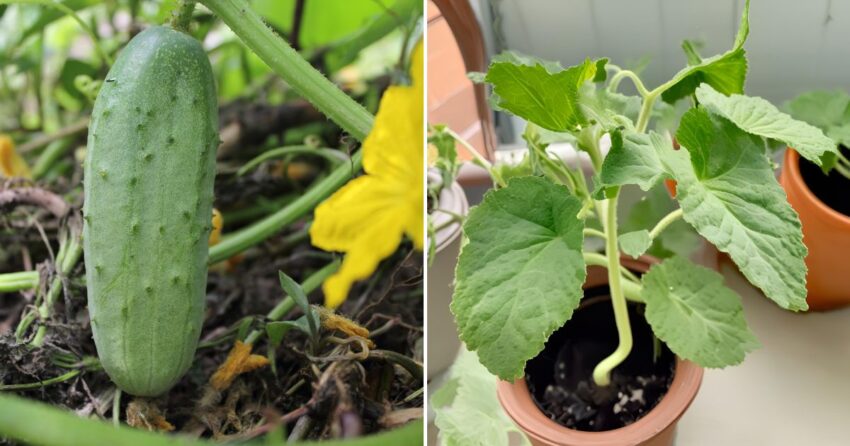Cucumbers, those crisp, refreshing veggies, are a garden favorite. Whether you’re a seasoned gardener or just getting your hands dirty for the first time, growing cucumbers can be a rewarding endeavor. This guide will walk you through the essentials of cultivating cucumbers successfully, from selecting the right varieties to harvesting a bountiful crop.
Choosing the Right Cucumber Variety
The journey to a successful cucumber harvest starts with selecting the right variety. There are two main types of cucumbers: slicing and pickling.
- Slicing Cucumbers: These are your typical salad cucumbers, often long and smooth-skinned. Popular varieties include ‘Marketmore 76’ and ‘Straight Eight.’
- Pickling Cucumbers: Shorter and often bumpier, these cucumbers are perfect for pickling. Varieties like ‘Boston Pickling’ and ‘National Pickling’ are well-suited for this purpose.
Preparing the Soil
Cucumbers thrive in well-drained, fertile soil. Here’s how to prepare your garden bed for optimal growth:
- Test Your Soil: A simple soil test can help determine pH levels and nutrient content. Cucumbers prefer slightly acidic to neutral soil, with a pH between 6.0 and 7.0.
- Amend the Soil: Work in plenty of organic matter, such as compost or aged manure, to improve soil structure and fertility.
- Ensure Good Drainage: Cucumbers hate wet feet. Raised beds or mounds can help ensure your soil drains well.
Planting Cucumbers
Timing and technique are crucial when it comes to planting cucumbers.
- Planting Time: Cucumbers are warm-weather plants. Wait until the soil has warmed to at least 70°F (21°C) before planting. This is usually a couple of weeks after the last frost date in your area.
- Seed or Transplant: You can start cucumbers from seeds or transplants. Seeds should be sown directly in the garden about an inch deep. If you start indoors, transplant seedlings carefully to avoid disturbing their roots.
- Spacing: Provide ample space for your cucumber plants. Space them about 12 to 18 inches apart in rows that are 4 to 6 feet apart.
Watering and Feeding
Cucumbers need consistent moisture, especially during flowering and fruiting.
- Watering: Water deeply and regularly, aiming for about 1 inch of water per week. Morning watering is best to reduce the risk of fungal diseases.
- Mulching: Apply a layer of mulch around your plants to conserve moisture and suppress weeds.
- Feeding: Cucumbers are heavy feeders. Use a balanced fertilizer at planting time and side-dress with compost or a slow-release fertilizer halfway through the growing season.
Supporting Your Cucumbers
Cucumbers love to climb, and providing support can increase your yield and keep fruits clean and straight.
- Trellising: Erect a sturdy trellis, fence, or A-frame for your cucumbers to climb. Train the vines gently to climb the support structure.
- Staking: For bush varieties, consider using stakes to keep the plants upright.
Pest and Disease Management
Cucumbers can fall prey to various pests and diseases, but with vigilant care, you can keep your plants healthy.
- Common Pests: Watch out for cucumber beetles, aphids, and spider mites. Handpick pests or use insecticidal soap if infestations get severe.
- Diseases: Powdery mildew, downy mildew, and bacterial wilt are common cucumber diseases. Prevent these by practicing crop rotation, spacing plants properly, and avoiding overhead watering.
Harvesting Cucumbers
Knowing when and how to harvest cucumbers is key to enjoying their peak flavor.
- Timing: Cucumbers are best picked when they are still young and tender. Slicing cucumbers should be harvested when they are 6 to 8 inches long, while pickling cucumbers are ready at 2 to 4 inches.
- Technique: Use a sharp knife or garden shears to cut the cucumbers from the vine, leaving a small stem attached to the fruit. This reduces the risk of damaging the plant.
Storing and Using Your Harvest
Freshly picked cucumbers can be stored in the refrigerator for up to a week. For longer storage, consider pickling or making cucumber relish.
- Refrigeration: Store cucumbers in the crisper drawer of your refrigerator, wrapped in a paper towel to absorb excess moisture.
- Pickling: Use pickling cucumbers to make homemade pickles. There are countless recipes, from simple dill pickles to spicy garlic varieties.
Troubleshooting Common Issues
Even with the best care, you might encounter a few hiccups along the way.
- Bitter Cucumbers: Bitterness can result from irregular watering or extreme temperatures. Ensure consistent watering and mulch to regulate soil temperature.
- Poor Fruit Set: If your plants are flowering but not setting fruit, it might be due to poor pollination. Encourage pollinators by planting flowers nearby and consider hand-pollinating if necessary.
Conclusion
Growing cucumbers can be a delightful and productive addition to your garden. By choosing the right variety, preparing your soil, providing proper care, and managing pests and diseases, you’ll be well on your way to a successful cucumber harvest. So, roll up your sleeves, get out into the garden, and enjoy the fruits of your labor!

